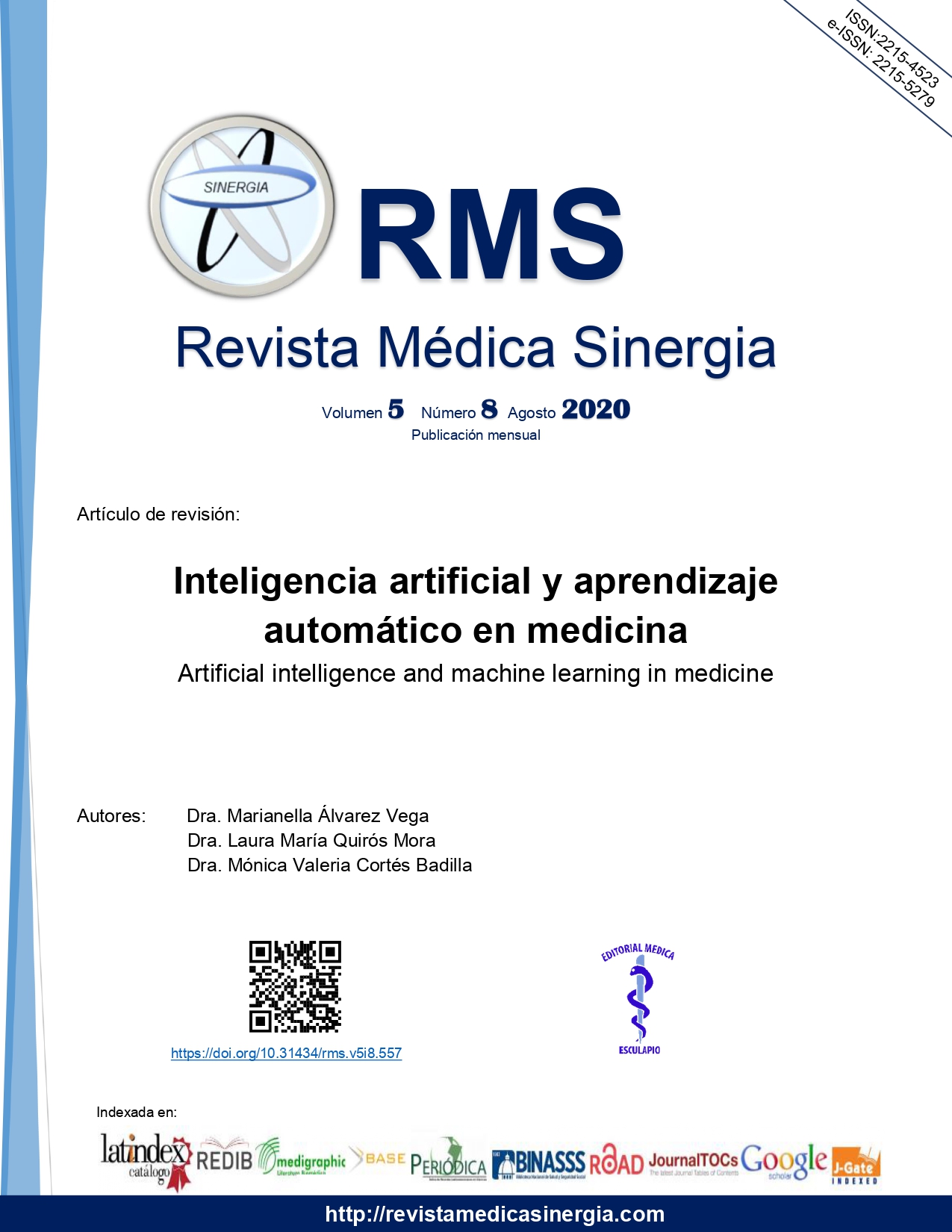Abstract
Machine learning is a powerful branch of Artificial Intelligence that has been used successfully in different industries. In the last few years with the increasing availability of clinical data stored in electronic format, the medical field has become an ideal environment for the development and application of these technologies. Machine learning has the potential to improve healthcare system by analyzing millions of clinical data to create prognostic, screening and diagnostic models. However, even though it is evident that the use of these algorithms can improve the quality of healthcare systems and patient’s life, an appropriate validation process is needed in order to implement these technologies into the clinical practice.
Keywords
References
Obermeyer Z, Lee T. Lost in Thought — The Limits of the Human Mind and the Future of Medicine. New England Journal of Medicine. 2017;377(13):1209-1211. https://doi.org/10.1056/NEJMp1705348
Gui C, Chan V. Machine learning in medicine. University of Western Ontario Medical Journal. 2017;86(2):76-78. https://doi.org/10.5206/uwomj.v86i2.2060
Char D, Shah N, Magnus D. Implementing Machine Learning in Health Care — Addressing Ethical Challenges. New England Journal of Medicine. 2018;378(11):981-983. https://doi.org/10.1056/NEJMp1714229
Yala A, Schuster T, Miles R, Barzilay R, Lehman C. A Deep Learning Model to Triage Screening Mammograms: A Simulation Study. Radiology. 2019;293(1). https://doi.org/10.1148/radiol.2019182908
Esteva A, Kuprel B, Novoa R, Ko J, Swetter S, Blau H et al. Dermatologist-level classificaction of skin cancer with deep neural networks. Nature. 2017;542: 115-118. https://doi.org/10.1038/nature21056
Ghorbani A, Ouyang D, Abid A, He B, Chen J, Harrington R et al. Deep learning interpretation of echocardiograms. Npj Digit Med. 2020;3(10). https://doi.org/10.1038/s41746-019-0216-8
Núñez Reiz A, Armengol de la Hoz M, Sánchez García M. Big Data Analysis y Machine Learning en medicina intensiva. Medicina Intensiva [Internet]. 2019 [Citado 25 febrero 2020];43(7):416-426. Disponible en: https://www.medintensiva.org/es-big-data-analysis-machine-learning-articulo-S0210569118303139
Chadha B. Clinical Oracle: Machine Learning in Medicine. Berkeley Scientific Journal;23(2). https://escholarship.org/uc/item/1kt5029r
Adamson A, Welch H. Machine Learning and the Cancer-Diagnosis Problem — No Gold Standard. New England Journal of Medicine. 2019;381(24):2285-2287. https://doi.org/10.1056/NEJMp1907407
Koenigkam M, Ferrei J, Tadao D, Magalhães A, Nogueira M, Mazzoncini de Azevedo P. Artificial intelligence, machine learning, computer-aided diagnosis, and radiomics: advances in imaging towards to precision medicine. Radiol Bras. 2019;52(6):387-396. https://doi.org/10.1590/0100-3984.2019.0049
Camacho D, Collins K, Powers R, Costello J, Collins J. Next- Generation Machine Learning for Biological Networks. Cell. 2018;173 (7): 1581-1592. https://doi.org/10.1016/j.cell.2018.05.015
Sidey-Gibbons J, Sidey-Gibbons C. Machine learning in medicine: a practical introduction. BMC Med Res Metodol. 2019;19(64). https://doi.org/10.1186/s12874-019-0681-4
Choy G, Khalilzadeh O, Michalski M, DO S, Samir A, Pianykh O et al. Current Applications and Future Impact of Machine Learning in Radiology. Radiology. 2018;288(2):318-328. https://doi.org/10.1148/radiol.2018171820
Deo R, Machine Learning in Medicine. Circulation. 2015;132(20):1920-1930. https://doi.org/10.1161/CIRCULATIONAHA.115.001593
Rajkomar A, Dean J, Kohane I. Machine Learning in Medicine. New England Journal of Medicine. 2019;380(14):1347-1358. https://doi.org/10.1056/NEJMra1814259
Erickson B, Korfiatis P, Akkus Z, Kline T. Machine Learning for Medical Imaging. RadioGraphics. 2017;37(2):505-515. https://doi.org/10.1148/rg.2017160130
Kourou K, Exarchos T, Exarchos K, Karamouzis M, Fotiadis D. Machine learning applications in cancer prognosis and prediction. Computational and Structural Biotechnology Journal. 2015;13:8-17. https://doi.org/10.1016/j.csbj.2014.11.005
Xu Y, Ju L, Tong J, Zhou C, Yang J. Machine Learning Algorithms for Predicting the Recurrence of Stage IV Colorectal Cancer After Tumor Resection. Sci Rep. 2020;10(2519). https://doi.org/10.1038/s41598-020-59115-y
Campanella G, Hanna M, Geneslaw L, Miraflor A, Krauss V, Busam K et al. Clinical-grade computational pathology using weakly supervised deep learning on whole slide images. Nat Med. 2019;25:1301-1309. https://doi.org/10.1038/s41591-019-0508-1
Vamathevan J, Clark D, Czodrowski P, Dunham I, Ferran E, Lee G et al. Applications of machine learning in drug discovery and development. Nat Rev Drug Discov. 2019;18:463-477. https://doi.org/10.1038/s41573-019-0024-5
Rifaioglu A, Atas H, Martin M, Cetin-Atalay R, Atalay V, Doğan T. Recent applications of deep learning and machine intelligence on in silico drug discovery: methods, tools and databases. Briefings in Bioinformatics. 2018;20(5):1878-1912. https://doi.org/10.1093/bib/bby061
Vayena E, Blasimme A, Cohen I. Machine learning in medicine: Addressing ethical challenges. PLoS Med. 2018; 15(11): e1002689. https://doi.org/10.1371/journal.pmed.1002689
Greene J, Lea A. Digital Futures Past — The Long Arc of Big Data in Medicine. New England Journal of Medicine. 2019;381(5):480-485. https://doi.org//10.1056/NEJMms1817674


